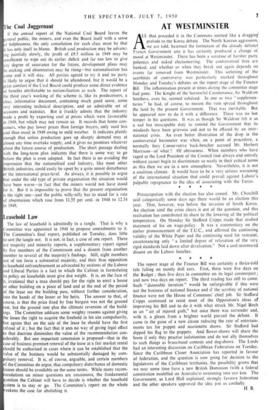if the annual report of the National Coal Board leaves
the eneral public, the miners, and even the Board itself with a sense
f helplessness, the only consolation for each class must be that t has only itself to blame. British coal production may be advanc- rig painfully slowly, the profit of £9.5 million in 1949 may be nsufficient to wipe out its earlier deficit and far too low to give ny degree of assurance for the future, development plans may e sticking and absenteeism may be rising—but nationalisation has
ome and it will stay. All parties agreed to try it and no party s likely to argue that it should be abandoned, but it would be a
treat comfort if the Coal Board could produce some direct evidence f benefits attributable to nationalisation as such. The report of he third year's working of the scheme is, like its predecessors, a lear, informative document, containing much good sense, some ery interesting technical description, and an admirable set of accounts and statistics. But it frankly admits that the industry ade a profit by exporting coal at prices which were favourable n 1949, but which may not remain so. It records that home con- umers, who pay lower prices than foreign buyers, only used less oat than usual in 1949 owing to mild weather. It indicates plainly nough that unless production goes up sharply demand may at (most any time overtake supply, and it gives no promises whatever bout the future course of production. The short passage dealing 'th the long-term plan indicates that there is some way to go efore the plan is even adopted. In fact there is no avoiding the mpression that the nationalised coal industry, like most other ritish industries, could easily be upset by a quite minor disturbance f the international price-level. As always, it is possible to argue hat under the old type of private organisation the situation would ave been worse—in fact that the miners would not have stood or it. But it is impossible to prove that the present organisation s the right one—and the public willy-nilly has to stand for a rate f absenteeism which rose from 11.55 per cent. in 1948 to 12.34 n 1949.






































 Previous page
Previous page